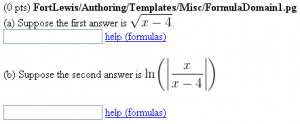Difference between revisions of "FormulaDomain1"
Paultpearson (talk | contribs) |
Paultpearson (talk | contribs) (Remove answerHints) |
||
| (One intermediate revision by the same user not shown) | |||
| Line 6: | Line 6: | ||
</p> |
</p> |
||
* File location in OPL: [https://github.com/openwebwork/webwork-open-problem-library/blob/master/OpenProblemLibrary/FortLewis/Authoring/Templates/Misc/FormulaDomain1.pg FortLewis/Authoring/Templates/Misc/FormulaDomain1.pg] |
* File location in OPL: [https://github.com/openwebwork/webwork-open-problem-library/blob/master/OpenProblemLibrary/FortLewis/Authoring/Templates/Misc/FormulaDomain1.pg FortLewis/Authoring/Templates/Misc/FormulaDomain1.pg] |
||
| + | * PGML location in OPL: [https://github.com/openwebwork/webwork-open-problem-library/blob/master/OpenProblemLibrary/FortLewis/Authoring/Templates/Misc/FormulaDomain1_PGML.pg FortLewis/Authoring/Templates/Misc/FormulaDomain1_PGML.pg] |
||
<br clear="all" /> |
<br clear="all" /> |
||
| Line 45: | Line 46: | ||
"MathObjects.pl", |
"MathObjects.pl", |
||
"AnswerFormatHelp.pl", |
"AnswerFormatHelp.pl", |
||
| − | "answerHints.pl", |
||
); |
); |
||
| Line 54: | Line 54: | ||
<p> |
<p> |
||
<b>Initialization:</b> |
<b>Initialization:</b> |
||
| − | We load <code>AnswerFormatHelp.pl</code> to provide help links to students |
+ | We load <code>AnswerFormatHelp.pl</code> to provide help links to students. |
</p> |
</p> |
||
</td> |
</td> |
||
| Line 128: | Line 128: | ||
ANS( $answer1->cmp() ); |
ANS( $answer1->cmp() ); |
||
| − | |||
| + | ANS( $answer2->cmp() ); |
||
| − | ANS( $answer2->cmp() |
||
| − | ->withPostFilter(AnswerHints( |
||
| − | [Compute("ln(x/(x-$a))"),Compute("ln(x)-ln(x-$a)")] => |
||
| − | "Don't forget to use absolute value", |
||
| − | )) |
||
| − | ); |
||
</pre> |
</pre> |
||
<td style="background-color:#eeccff;padding:7px;"> |
<td style="background-color:#eeccff;padding:7px;"> |
||
| Line 140: | Line 134: | ||
<b>Answer Evaluation:</b> |
<b>Answer Evaluation:</b> |
||
It is possible to get diagnostic information about the answer checker using <code>cmp(diagnostics=>1)</code>. When diagnostics are turned on and a student answer is submitted, you will get a graph of the correct answer and the student answer on the same graph, as well as a table that specifies which test points were used by the answer checker, and how much of a difference there was between the student answer and the correct answer at these checkpoints. To test the reliability of your answer checker, it is good to click the reload button on your browser several times after a student answer has been submitted, since reloading changes the test points used. |
It is possible to get diagnostic information about the answer checker using <code>cmp(diagnostics=>1)</code>. When diagnostics are turned on and a student answer is submitted, you will get a graph of the correct answer and the student answer on the same graph, as well as a table that specifies which test points were used by the answer checker, and how much of a difference there was between the student answer and the correct answer at these checkpoints. To test the reliability of your answer checker, it is good to click the reload button on your browser several times after a student answer has been submitted, since reloading changes the test points used. |
||
| − | </p> |
||
| − | <p> |
||
| − | For the second answer, we have used <code>AnswerHints</code> to give students who enter particular answers customized feedback messages. For more details, please see [http://webwork.maa.org/wiki/AnswerHints answer hints] in the index of problem techniques. |
||
</p> |
</p> |
||
</td> |
</td> |
||
Revision as of 13:10, 31 July 2015
Answer is a Function with Domain Issues
This PG code shows how to set the domain and test points for a formula.
- File location in OPL: FortLewis/Authoring/Templates/Misc/FormulaDomain1.pg
- PGML location in OPL: FortLewis/Authoring/Templates/Misc/FormulaDomain1_PGML.pg
| PG problem file | Explanation |
|---|---|
|
Problem tagging: |
|
DOCUMENT(); loadMacros( "PGstandard.pl", "MathObjects.pl", "AnswerFormatHelp.pl", ); TEXT(beginproblem()); |
Initialization:
We load |
Context("Numeric");
$a = random(2,5,1);
$answer1 = Compute("sqrt(x-$a)");
$answer1->{limits} = [$a+1,$a+4];
$answer2 = Compute("ln(abs( x / (x-$a) ))");
$answer2->{test_points} = [[-5],[-4],[1],[$a-1],[7],[8]];
|
Setup:
We restrict the domain of function evaluation using
The domain for It is possible to set the domain once for all of the functions within a particular context. For more details, please see formula test points in the index of problem techniques. |
Context()->texStrings;
BEGIN_TEXT
(a) Suppose the first answer is
\( \displaystyle $answer1 \).
$BR
\{ ans_rule(20) \}
\{ AnswerFormatHelp("formulas") \}
$BR
$BR
(b) Suppose the second answer is
\( \displaystyle $answer2 \)
$BR
\{ ans_rule(20) \}
\{ AnswerFormatHelp("formulas") \}
END_TEXT
Context()->normalStrings;
|
Main Text: Notice that in this multipart question we have grouped the text for each part together in a block, put each answer blank on a new line immediately below each block of text, and added extra space between each part. This should make the question easy to read both in HTML and PDF format. |
$showPartialCorrectAnswers = 1; ANS( $answer1->cmp() ); ANS( $answer2->cmp() ); |
Answer Evaluation:
It is possible to get diagnostic information about the answer checker using |
Context()->texStrings;
BEGIN_SOLUTION
${PAR}SOLUTION:${PAR}
Solution explanation goes here.
END_SOLUTION
Context()->normalStrings;
COMMENT('MathObject version.');
ENDDOCUMENT();
|
Solution: |
